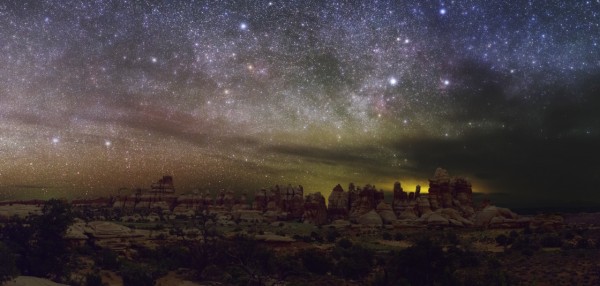One Third of the World Can No Longer See the Milky Way Due to Light Pollution
| Ana Verayo | | Jun 11, 2016 03:01 AM EDT |
(Photo : NOAA) More than 80 percent of Americans and one third of humanity can no longer see the Milky Way from the skies.
A new study reveals how the Milky Way is slowly disappearing from sight, as light pollution now blocks the majestic galaxy from the night skies, preventing more than one third of the world from seeing it.
According to co-author of the study, Chris Elvidge from the National Center for Environmental Information of NOAA (National Oceanic and Atmospheric Administration), this occurrence is not entirely new, as home lighting , street lights, highways and busy, sprawling cities across the United States have increased dramatically after World War II.
Like Us on Facebook
Elvidge explains how urban centers are now hindering generations of citizens who cannot view the Milky Way from the skies, which is a shame that they cannot do so. This light pollution emits a night time glow that can reach for hundreds of miles, that can partially obscure stars and constellations, including galaxies, even for residential areas that are far from cities and urban centers.
According to lead author of the study, Fabio Falchi from the Light Pollution Science and Technology Institute in Italy, for example, if you live near Death Valley National Park, there only very few sources of light pollution, however, if you are closer to Las Vegas, the sky's brightness will increase very dramatically.
Using the NOAA/NASA Suomi National Polar-orbiting Partnership satellite to obtain this data, scientists conducted the most intensive global assessment of light pollution yet, using low light imaging and then consolidating this data from more than 30,000 sky brightness monitors in order to map out the different levels of light pollution within a radius of 120 miles per location.
Results reveals how Canada, Spain, Kuwait, Singapore and South Korea have the worst light pollution. In the U.S., the east coast suffers from the most bright illumination from cities, obscuring the view of the Milky Way.
Falchi adds how he is hoping that this new research and new light pollution world atlas can raise new awareness about the adverse impacts of light pollution that most people living in urban centers are not even made aware of, and the amount of harm it can cause the environment.
Some of the ecological impacts of light pollution are disruption of the natural behaviors of nocturnal animals, disrupt underwater ecosystems and even the shifting of migratory patterns of birds. This excessive light pollution can also become disruptive to human circadian rhythms or sleep patterns, that can also hinder the effects of sleep like rest, repair and recovery that lead to depression, obesity and even an increase risks of cancer, according to researchers.
Elvidge suggests how artificial lighting and illumination can be reduced by limiting and shielding it from escaping into the atmosphere, reducing light pollution in the process. Using LED lighting and warmer color spectrums as opposed to blue ones can also help promote better circadian rhythms as well.
This new study is published in the journal Science Advances.
Tagslight pollution, milky way galaxy, milky way light pollution, how to see milky way, milky way night skies, milky way disappearing
©2015 Chinatopix All rights reserved. Do not reproduce without permission
EDITOR'S PICKS
-

Did the Trump administration just announce plans for a trade war with ‘hostile’ China and Russia?
-

US Senate passes Taiwan travel bill slammed by China
-

As Yan Sihong’s family grieves, here are other Chinese students who went missing abroad. Some have never been found
-

Beijing blasts Western critics who ‘smear China’ with the term sharp power
-

China Envoy Seeks to Defuse Tensions With U.S. as a Trade War Brews
-

Singapore's Deputy PM Provides Bitcoin Vote of Confidence Amid China's Blanket Bans
-

China warns investors over risks in overseas virtual currency trading
-

Chinese government most trustworthy: survey
-

Kashima Antlers On Course For Back-To-Back Titles
MOST POPULAR
LATEST NEWS
Zhou Yongkang: China's Former Security Chief Sentenced to Life in Prison

China's former Chief of the Ministry of Public Security, Zhou Yongkang, has been given a life sentence after he was found guilty of abusing his office, bribery and deliberately ... Full Article
TRENDING STORY

China Pork Prices Expected to Stabilize As The Supplies Recover

Elephone P9000 Smartphone is now on Sale on Amazon India

There's a Big Chance Cliffhangers Won't Still Be Resolved When Grey's Anatomy Season 13 Returns

Supreme Court Ruled on Samsung vs Apple Dispute for Patent Infringement

Microsoft Surface Pro 5 Rumors and Release Date: What is the Latest?










